We, Robots! (Part 18): Still Hope For H-B


As the late ‘80’s and ‘90’s settled in, and the era of television animation resurgence dawned, Hanna-Barbera, the television war horse who had seen better days, yet never completely disappeared from the scene, was a bit slow to rise to the new occasion, but began to realize that writing restrictions on content and violence had loosened, and that a new breed of younger animators were making their mark on the field. Plus, with the new interest in the medium, budget increases were available that had been unthought of in previous seasons, allowing for a better-looking product on screen. Thus, the studio’s output gradually improved in quality, allowing the company to go out on a high note instead of as a shadow of its former glory. It is difficult to say how much, if any, creative control was maintained by Bill and Joe at this time, or if they served as mere figureheads, as most of the controlling interest in the firm seems to have been sold to Ted Turner, developing the basis for his establishment of Cartoon Network and afterwards Boomerang. The distinction between H-B and Cartoon Network product becomes rather blurred in the end, some projects unnoticeably making the transition from one name to the other. However, the founders were not entirely forgotten, and, in a classy move, they would be called upon on occasion to display their original talents to the public once again, in a small number of prestige shorts in which they would re-assume the director’s chair, demonstrating that their brand of humor could still be created in a modern setting.
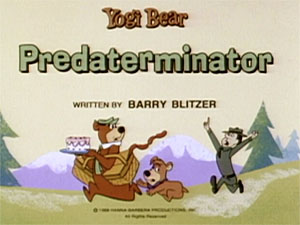 The New Yogi Bear Show included a mediocre episode titled Predaterminator (10/14/88) – Yogi, not content with sticking to Erector Sets, builds a robot, its design featuring a TV monitor for a head, a satellite dish turned upwards for its hips (held up by shoulder suspenders!), a pair of wheels for feet, a bear trap for a jaw, and a duplicate of Yogi’s hat. It’s strength “will make Arnold Scwartzeknuckle look like a sissy”, boasts Yogi. Yogi uses the robot to round up goodies by remote control. It of course goes haywire for no apparent reason, interrupting Ranger Smith’s “quiet afternoon”. Most of the material is uninteresting. Perhaps the most curious notes of the short are its complete departure from the track history of Ranger Smith, as previously established in “Wound Up Bear”, in that Smith, previously revealing his marriage to one “Mabel”, is now attempting to impress a new girlfriend, Bernice, to solve the problem of his lonely existence. When did Smith or the missus take that excursion to Reno? A further revelation is made of Smith’s first name, of which he expresses some embarrassment in front of Yogi – “Francis”! A final odd note about the short is a choice of musical cue for the closing chase – an updated orchestration of – the Snagglepuss theme?
The New Yogi Bear Show included a mediocre episode titled Predaterminator (10/14/88) – Yogi, not content with sticking to Erector Sets, builds a robot, its design featuring a TV monitor for a head, a satellite dish turned upwards for its hips (held up by shoulder suspenders!), a pair of wheels for feet, a bear trap for a jaw, and a duplicate of Yogi’s hat. It’s strength “will make Arnold Scwartzeknuckle look like a sissy”, boasts Yogi. Yogi uses the robot to round up goodies by remote control. It of course goes haywire for no apparent reason, interrupting Ranger Smith’s “quiet afternoon”. Most of the material is uninteresting. Perhaps the most curious notes of the short are its complete departure from the track history of Ranger Smith, as previously established in “Wound Up Bear”, in that Smith, previously revealing his marriage to one “Mabel”, is now attempting to impress a new girlfriend, Bernice, to solve the problem of his lonely existence. When did Smith or the missus take that excursion to Reno? A further revelation is made of Smith’s first name, of which he expresses some embarrassment in front of Yogi – “Francis”! A final odd note about the short is a choice of musical cue for the closing chase – an updated orchestration of – the Snagglepuss theme?
 Another cartoon that doesn’t live up to potential, from the Tom and Jerry Kids show, is Termi-Maid (5/8/92). A mishap with an RC car causes the familiar sight of a living room trashed in the T&J above. Tom’s owner (Caucasian, not Mammy), hires a maid, who is robotic, but by no means Rosie. She is shaped like a stack of inverted bowls of different diameters piled one atop the other, and has a permanently stern face and a voice impersonating a female Arnold Schwartzenegger. Her mission – to terminate messes. With at least six telescoping arms and nozzles, she gets to work. However, Tom is strictly in her way, and gets forcibly cast aside. Jerry, too, can’t make a raid on the refrigerator without also being targeted as a mess-maker by the robot’s radar. At one point, she pursues the two of them, transformed into the mode of a Sherman Tank. Tom and Jerry attempt interference by sending in a pair of circling toy planes, leaving the maid swatting at them like King Kong. The ending falls completely flat, and makes no sense in the continuity (as the maid was earlier seen washing windows), as she announces “Sorry I don’t do windows”, and changes Arnold’s catch-phrase to “I won’t be back.”
Another cartoon that doesn’t live up to potential, from the Tom and Jerry Kids show, is Termi-Maid (5/8/92). A mishap with an RC car causes the familiar sight of a living room trashed in the T&J above. Tom’s owner (Caucasian, not Mammy), hires a maid, who is robotic, but by no means Rosie. She is shaped like a stack of inverted bowls of different diameters piled one atop the other, and has a permanently stern face and a voice impersonating a female Arnold Schwartzenegger. Her mission – to terminate messes. With at least six telescoping arms and nozzles, she gets to work. However, Tom is strictly in her way, and gets forcibly cast aside. Jerry, too, can’t make a raid on the refrigerator without also being targeted as a mess-maker by the robot’s radar. At one point, she pursues the two of them, transformed into the mode of a Sherman Tank. Tom and Jerry attempt interference by sending in a pair of circling toy planes, leaving the maid swatting at them like King Kong. The ending falls completely flat, and makes no sense in the continuity (as the maid was earlier seen washing windows), as she announces “Sorry I don’t do windows”, and changes Arnold’s catch-phrase to “I won’t be back.”
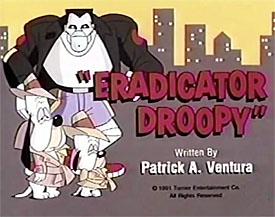 Eradicator Droopy (Droopy and Dripple, 12/7/91), continues in the send-ups of the Arnold franchise, with more success. Professor Wacko McWolf has created a monster – a metallic giant, with the face of Frankenstein, the voice of Schwatzenegger, and the short pants and demeanor of a juvenile delinquent – known as the Eradicator. The creation stomps through the streets tearing up public and private property, and in his spare time robs banks. At the foot of the steps of an imposing bank institution, the monster grabs hold of a lamp post, and pulls it as if the lever of a one-armed bandit. Three windows of the bank edifice whirl like wheels, coming up with readouts in the shape of dollar signs, and the bottom step of the staircase opens like a cash register till to reveal the holdings of the vault. The monster sucks up the loot through a vacuum extension sprouting from a hatch in its chest, repeating the line from the previous film, “I won’t be back”, then returns to McWolf’s lab. He makes a non-graceful entrance, right through the wall. “You big dummy. Don’t I always tell ya to knock?” shouts McWolf. With a giant fist, the creature knocks hard on the wolf’s head, mashing him flat. “Knock Knock”, says the monster coldly. The monster doesn’t take kindly to being called “dummy”, but McWolf reminds him “You are a brainless creature controlled by my will.” “Oh, ya…I forgot”, replies the robot. “Sheesh, who’s doin’ the casting on these pictures?”, McWolf asides to the audience. The monster dumps out the loot for the Professor, but reminds him, “50-50″. “Are you off your floppy disc?”, shouts McWolf. The monster’s response is to drop a huge gold bar straight upon the wolf’s head. “Okay, okay, 50-50″, comes the muffled voice of the twice-flattened wolf.
Eradicator Droopy (Droopy and Dripple, 12/7/91), continues in the send-ups of the Arnold franchise, with more success. Professor Wacko McWolf has created a monster – a metallic giant, with the face of Frankenstein, the voice of Schwatzenegger, and the short pants and demeanor of a juvenile delinquent – known as the Eradicator. The creation stomps through the streets tearing up public and private property, and in his spare time robs banks. At the foot of the steps of an imposing bank institution, the monster grabs hold of a lamp post, and pulls it as if the lever of a one-armed bandit. Three windows of the bank edifice whirl like wheels, coming up with readouts in the shape of dollar signs, and the bottom step of the staircase opens like a cash register till to reveal the holdings of the vault. The monster sucks up the loot through a vacuum extension sprouting from a hatch in its chest, repeating the line from the previous film, “I won’t be back”, then returns to McWolf’s lab. He makes a non-graceful entrance, right through the wall. “You big dummy. Don’t I always tell ya to knock?” shouts McWolf. With a giant fist, the creature knocks hard on the wolf’s head, mashing him flat. “Knock Knock”, says the monster coldly. The monster doesn’t take kindly to being called “dummy”, but McWolf reminds him “You are a brainless creature controlled by my will.” “Oh, ya…I forgot”, replies the robot. “Sheesh, who’s doin’ the casting on these pictures?”, McWolf asides to the audience. The monster dumps out the loot for the Professor, but reminds him, “50-50″. “Are you off your floppy disc?”, shouts McWolf. The monster’s response is to drop a huge gold bar straight upon the wolf’s head. “Okay, okay, 50-50″, comes the muffled voice of the twice-flattened wolf.
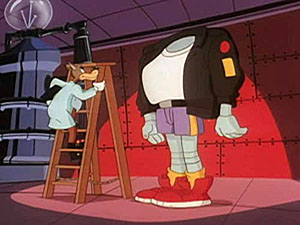 Detectives Droopy and Dripple are called in on the case. They receive a telephonic ransom demand for “Fifty trillion bucks in small unmarked bills, a billion-dollar portfolio in junk bonds, a space shuttle for my getaway, and a lifetime supply of broccoli.” Droopy knows at once it is McWolf, for whom broccoli is a lifelong weakness. “There’s something not quite right about a guy who likes broccoli”, observes Dripple. The dogs set out in their patrol car, running right into the monster’s ankles. “I’m gonna crush you up”, bellows the monster/ “This is very anti-social behavior, even for a cartoon”, observes Droopy, pressing a button on the dashboard. The hood of the car opens up, and the monster is socked by an oversized boxing glove on a jack-in-the-box spring. The monster smashes hard into the side of a brick wall. McWolf drives by with a sanitation truck, scooping up the pieces, and taking them back to his lab for reassembly. The monster soon resumes his rampage, though delivering McWolg another sock for again calling him “Dummy”. Droopy brings along his secretary. Miss Vavoom (the equivalent of Tex Avery’s Red) to take notes on the destruction as evidence. Her pencil breaks, and she asks the monster to bend down to her. He proves useful when she sticks the pencil in his mouth, his jaws automatically providing a precision sharpening. She suggests maybe next time, he can do her toenails. McWolf remotely commands the robot to bring back the gal. The monster seizes her, then climbs the tallest building like King Kong. Droopy and Dripple swoop at him in a helicopter, and the monster swats at them, inadvertently dropping the girl. Droopy and Dropple flip open the windshield of their helicopter, and catch the girl in mid-fall. Her main complaint is that her hair is a mess. The monster follows, by popping his own helicopter blades out of his head. An aerial chase begins, but quickly ends when Droopy flies among and over a set of electric power wires. The monster is caught in the wires, which stretch like a slingshot, then catapult the monster back to the Professor’s lab, right through the Wolf’s viewing monitor into his face. The monster once again lies as a heap of parts, the Wolf buried among the,. Droopy arrives to snap the cuffs upon McWolf, who complains that he’d have gotten away with it if it hadn’t been for his “big dummy.” The monster’s head is still conscious, and still in control of one hand, allowing him to flatten the wolf for the insult once again. Droopy announces that McWolf will be spending the rest of his life in jail. “Do they have broccoli there?” “All you can eat”, responds Dripple. “I can live with that”, replies McWolf.
Detectives Droopy and Dripple are called in on the case. They receive a telephonic ransom demand for “Fifty trillion bucks in small unmarked bills, a billion-dollar portfolio in junk bonds, a space shuttle for my getaway, and a lifetime supply of broccoli.” Droopy knows at once it is McWolf, for whom broccoli is a lifelong weakness. “There’s something not quite right about a guy who likes broccoli”, observes Dripple. The dogs set out in their patrol car, running right into the monster’s ankles. “I’m gonna crush you up”, bellows the monster/ “This is very anti-social behavior, even for a cartoon”, observes Droopy, pressing a button on the dashboard. The hood of the car opens up, and the monster is socked by an oversized boxing glove on a jack-in-the-box spring. The monster smashes hard into the side of a brick wall. McWolf drives by with a sanitation truck, scooping up the pieces, and taking them back to his lab for reassembly. The monster soon resumes his rampage, though delivering McWolg another sock for again calling him “Dummy”. Droopy brings along his secretary. Miss Vavoom (the equivalent of Tex Avery’s Red) to take notes on the destruction as evidence. Her pencil breaks, and she asks the monster to bend down to her. He proves useful when she sticks the pencil in his mouth, his jaws automatically providing a precision sharpening. She suggests maybe next time, he can do her toenails. McWolf remotely commands the robot to bring back the gal. The monster seizes her, then climbs the tallest building like King Kong. Droopy and Dripple swoop at him in a helicopter, and the monster swats at them, inadvertently dropping the girl. Droopy and Dropple flip open the windshield of their helicopter, and catch the girl in mid-fall. Her main complaint is that her hair is a mess. The monster follows, by popping his own helicopter blades out of his head. An aerial chase begins, but quickly ends when Droopy flies among and over a set of electric power wires. The monster is caught in the wires, which stretch like a slingshot, then catapult the monster back to the Professor’s lab, right through the Wolf’s viewing monitor into his face. The monster once again lies as a heap of parts, the Wolf buried among the,. Droopy arrives to snap the cuffs upon McWolf, who complains that he’d have gotten away with it if it hadn’t been for his “big dummy.” The monster’s head is still conscious, and still in control of one hand, allowing him to flatten the wolf for the insult once again. Droopy announces that McWolf will be spending the rest of his life in jail. “Do they have broccoli there?” “All you can eat”, responds Dripple. “I can live with that”, replies McWolf.
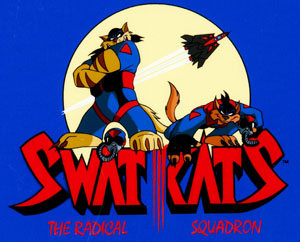 Swat Kats: The Radical Squadron, was a departure from usual H-B form. It marked a return to the action-adventure format previously driven into the ground by the studio in the late- 60’s, but with a new breed of writers and animators at the helm. Despite its anthropomorphic world inhabited by an all-feline cast, it attempts to follow in the mold of “Batman, the Animated Series” which had premiered the preceding year (right down to copying the style of a dissolve from the studio logo directly into the action in its credit sequence), taking itself in a more serious tone than was typical of any of the studio’s previous efforts save Jonny Quest. It nevertheless managed to spice up the dialogue with one-liners and pointed banter, and its characters had substantially more personality and depth than the cardboard cutouts that served as superheroes in the studio’s early efforts. It centers upon two washed-out pilots (T-Bone and Razor), disgracefully assigned to manage a junkyard for discarded military supplies. They, however, convert the available raw material into fantastic vehicles and super-weapons, and become secret vigilantes to fight crime in their equivalent of Gotham. Like Batman, they are misunderstood by a law enforcement figure, Commander Feral (played in effective straight manner by Gary Owens), who would love to have their heads on a platter were other cooler heads (such as the efficient female deputy mayor) not to intervene on the Swat Kats’ behalf. The Kats, like Underdog, are often super-destructive of civic and private property in their battles (part of why they washed out as pilots in the first place), but still save the city’s neck again and again, leaving mixed feelings about them between the deputy mayor and Feral. The series raised the bar on standards and practices for cartoon violence in American television, some of its incidents developing such intensity of weapon use that the series was cancelled by the executive “shirts” before completing its contracted quota of episodes. Despite this, in this viewer’s opinion, this may be the only instance where H-B beat Disney at their own game, as a comparison of the series with Disney’s similar and equally outrageous “The Mighty Ducks” leaves the Ducks in the dust, with the Kats demonstrating more memorable, winning personalities, and more coherent, believable storylines.
Swat Kats: The Radical Squadron, was a departure from usual H-B form. It marked a return to the action-adventure format previously driven into the ground by the studio in the late- 60’s, but with a new breed of writers and animators at the helm. Despite its anthropomorphic world inhabited by an all-feline cast, it attempts to follow in the mold of “Batman, the Animated Series” which had premiered the preceding year (right down to copying the style of a dissolve from the studio logo directly into the action in its credit sequence), taking itself in a more serious tone than was typical of any of the studio’s previous efforts save Jonny Quest. It nevertheless managed to spice up the dialogue with one-liners and pointed banter, and its characters had substantially more personality and depth than the cardboard cutouts that served as superheroes in the studio’s early efforts. It centers upon two washed-out pilots (T-Bone and Razor), disgracefully assigned to manage a junkyard for discarded military supplies. They, however, convert the available raw material into fantastic vehicles and super-weapons, and become secret vigilantes to fight crime in their equivalent of Gotham. Like Batman, they are misunderstood by a law enforcement figure, Commander Feral (played in effective straight manner by Gary Owens), who would love to have their heads on a platter were other cooler heads (such as the efficient female deputy mayor) not to intervene on the Swat Kats’ behalf. The Kats, like Underdog, are often super-destructive of civic and private property in their battles (part of why they washed out as pilots in the first place), but still save the city’s neck again and again, leaving mixed feelings about them between the deputy mayor and Feral. The series raised the bar on standards and practices for cartoon violence in American television, some of its incidents developing such intensity of weapon use that the series was cancelled by the executive “shirts” before completing its contracted quota of episodes. Despite this, in this viewer’s opinion, this may be the only instance where H-B beat Disney at their own game, as a comparison of the series with Disney’s similar and equally outrageous “The Mighty Ducks” leaves the Ducks in the dust, with the Kats demonstrating more memorable, winning personalities, and more coherent, believable storylines.
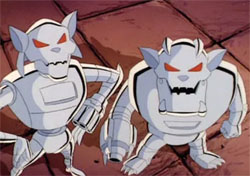 A pair of related episodes pit the Kats against two robotic personalities. The Metallikats (10/9/93), introduces a husband and wife team of gangsters, Mac and Molly Mange, who are engaging characters in and of themselves, sharing a relationship of classic insults and barbed banter, similar in nature to Don Ameche and Frances Langford’s “The Bickersons”, yet somehow manage through the war of words to act as an effective team to pull off capers and dominate the underworld. They have, however, become more than your garden-variety breed of hoods. Sent up for a stretch in a maximum-security island prison, they stage an escape in a rowboat, attempting to navigate through a pea-soup fog. Their boat is sliced in two when they collide with the bow of an ocean liner. What is left of them washes up on the shore of another remote island. Their barely-viable remains are discovered by a scientist specializing in robotics and weaponry, who transports them to his lab, and performs what is essentially a revisit to the “8th Man” surgery, transferring all of their memories into digital discs inside the mechanical brains of a pair of robots matching their dimensions, but constructed of steel rather than skin. The robots acquire the personalities of their donors – and their continued consciousness and twisted desires to resume their life of crime. The scientist, whose previous creations have all been adapted to destructive military use, hopes to exhibit the robots to the scientific community, as a means of redeeming himself by revealing a process whereby the lives of great men (er, cats) can be saved and preserved. The evil duo have other ideas, hijack a futuristic assault vehicle from the professor’s lab, and make a break to exhibit their enhanced power and strength in their own style. The two quickly muscle in on the competition, leaving an entire rival gang in a warehouse explosion that is depicted so violently, the only implausibility of the script is that the gang members somehow seem to come out of the resulting fire alive. The Swat Kats are in fact the ones responsible for answering the sound of the explosion, and dousing the flames with a foam bomb. They then turn their attentions to tracking down the perpetrators. The writers avoid some of the obvious avenues for attempting to stop the robots’ rampage, ruling out water, for example, as having no effect because the professor made them waterproof. Energy disruptors also accomplish nothing but making Mac feel ticklish. Salvation comes from an unexpected move of desperation, as one of the Kats smashes across the back of Mac a large hotel urn loaded with sand for use as an ash tray. The sand spills into the rear hatch of the robot, getting stuck in its internal gears, and grates the robot to a standstill, making him explode. Molly grabs hold of the wing of the Kats’ jet to take revenge, but as she reaches for its pilot, he jettisons the jet canopy, knocking her backwards to cling to the jet exhaust tubes below the craft. The pilot sends the jet in a vertical climb along the wall of a tall skyscraper, dragging the robot violently along the wall, until she loses her grip and falls 40 stories, smashing to bits on the pavement below. The debris that is the two is picked up by a trash truck and hauled away – but the driver of the truck turns out to be the Professor, taking the delinquent duo back to his lab for a overhaul. It also becomes evident that neither of the robots have been totally destroyed, as their disconnected heads continue to fling insults at each other for the entirety of the long drive home.
A pair of related episodes pit the Kats against two robotic personalities. The Metallikats (10/9/93), introduces a husband and wife team of gangsters, Mac and Molly Mange, who are engaging characters in and of themselves, sharing a relationship of classic insults and barbed banter, similar in nature to Don Ameche and Frances Langford’s “The Bickersons”, yet somehow manage through the war of words to act as an effective team to pull off capers and dominate the underworld. They have, however, become more than your garden-variety breed of hoods. Sent up for a stretch in a maximum-security island prison, they stage an escape in a rowboat, attempting to navigate through a pea-soup fog. Their boat is sliced in two when they collide with the bow of an ocean liner. What is left of them washes up on the shore of another remote island. Their barely-viable remains are discovered by a scientist specializing in robotics and weaponry, who transports them to his lab, and performs what is essentially a revisit to the “8th Man” surgery, transferring all of their memories into digital discs inside the mechanical brains of a pair of robots matching their dimensions, but constructed of steel rather than skin. The robots acquire the personalities of their donors – and their continued consciousness and twisted desires to resume their life of crime. The scientist, whose previous creations have all been adapted to destructive military use, hopes to exhibit the robots to the scientific community, as a means of redeeming himself by revealing a process whereby the lives of great men (er, cats) can be saved and preserved. The evil duo have other ideas, hijack a futuristic assault vehicle from the professor’s lab, and make a break to exhibit their enhanced power and strength in their own style. The two quickly muscle in on the competition, leaving an entire rival gang in a warehouse explosion that is depicted so violently, the only implausibility of the script is that the gang members somehow seem to come out of the resulting fire alive. The Swat Kats are in fact the ones responsible for answering the sound of the explosion, and dousing the flames with a foam bomb. They then turn their attentions to tracking down the perpetrators. The writers avoid some of the obvious avenues for attempting to stop the robots’ rampage, ruling out water, for example, as having no effect because the professor made them waterproof. Energy disruptors also accomplish nothing but making Mac feel ticklish. Salvation comes from an unexpected move of desperation, as one of the Kats smashes across the back of Mac a large hotel urn loaded with sand for use as an ash tray. The sand spills into the rear hatch of the robot, getting stuck in its internal gears, and grates the robot to a standstill, making him explode. Molly grabs hold of the wing of the Kats’ jet to take revenge, but as she reaches for its pilot, he jettisons the jet canopy, knocking her backwards to cling to the jet exhaust tubes below the craft. The pilot sends the jet in a vertical climb along the wall of a tall skyscraper, dragging the robot violently along the wall, until she loses her grip and falls 40 stories, smashing to bits on the pavement below. The debris that is the two is picked up by a trash truck and hauled away – but the driver of the truck turns out to be the Professor, taking the delinquent duo back to his lab for a overhaul. It also becomes evident that neither of the robots have been totally destroyed, as their disconnected heads continue to fling insults at each other for the entirety of the long drive home.
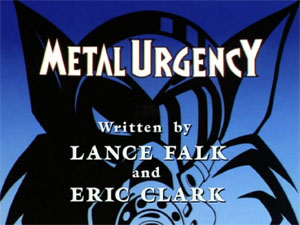 Metal Urgency (11/13/93) picks up where the last episode left off. The Professor has succeeded in reassembling the robots, who are temporarily strapped into holding units against a wall. He announces that he has developed a program which he intends to run through their hard drives, capable of erasing their criminal tendencies, and rendering them in a state to assume positions of usefulness to society, such as a chauffeur and maid. These developments don’t sit well in the craw of the robotic couple, who exert their strength to break their bonds, then crash through a wall, stealing an old truck to make another getaway. They soon realize their transportation is a broken-down wreck, and long for their classy assault vehicle seen in the previous episode. Mac recalls overhearing before they were towed away in the trash truck that the vehicle was going to be towed to some kind of impound lot. The lot turns out to be the Swat Kats’ military junkyard, where Commander Feral has ordered it to remain, little realizing into whose hands he has delivered it. The robots infiltrate the lot in the Swat Kats’ absence, easily locating their old “wheels”. However, Mac, due to his tremendous weight, discovers something a person of normal size would never notice in tramping over the junkyard grounds – a large area that sounds as if it were hollow below ground. Determined to investigate this strange find, Mac discovers the hidden hangar of the Swat Kats. Now the couple hope to kill two birds with one stone – not only get their vehicle, but get revenge on the Swat Kats too. When the Kats return, a desperate battle for their own survival takes place within the hangar. Although they survive, crushing the robots’ bodies under the elevating platform carrying their jet, the villains escape by detaching their metal heads and crawling away atop spider-leg like connectors – holding within their hard drives the knowledge of who the Swat Kats are – information that would surely result in the end of the Kats’ operations should it ever fall into the hands of Feral.
Metal Urgency (11/13/93) picks up where the last episode left off. The Professor has succeeded in reassembling the robots, who are temporarily strapped into holding units against a wall. He announces that he has developed a program which he intends to run through their hard drives, capable of erasing their criminal tendencies, and rendering them in a state to assume positions of usefulness to society, such as a chauffeur and maid. These developments don’t sit well in the craw of the robotic couple, who exert their strength to break their bonds, then crash through a wall, stealing an old truck to make another getaway. They soon realize their transportation is a broken-down wreck, and long for their classy assault vehicle seen in the previous episode. Mac recalls overhearing before they were towed away in the trash truck that the vehicle was going to be towed to some kind of impound lot. The lot turns out to be the Swat Kats’ military junkyard, where Commander Feral has ordered it to remain, little realizing into whose hands he has delivered it. The robots infiltrate the lot in the Swat Kats’ absence, easily locating their old “wheels”. However, Mac, due to his tremendous weight, discovers something a person of normal size would never notice in tramping over the junkyard grounds – a large area that sounds as if it were hollow below ground. Determined to investigate this strange find, Mac discovers the hidden hangar of the Swat Kats. Now the couple hope to kill two birds with one stone – not only get their vehicle, but get revenge on the Swat Kats too. When the Kats return, a desperate battle for their own survival takes place within the hangar. Although they survive, crushing the robots’ bodies under the elevating platform carrying their jet, the villains escape by detaching their metal heads and crawling away atop spider-leg like connectors – holding within their hard drives the knowledge of who the Swat Kats are – information that would surely result in the end of the Kats’ operations should it ever fall into the hands of Feral.
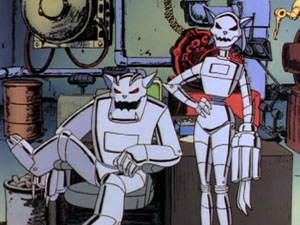 Making their way to Feral’s military base of operations, the robot heads encounter two giant military robots previously created by the professor, and commandeer the hugely-powerful automatons by climbing into their control centers. They begin a rampage, and taunt the Swat Kats to come and get them, or have their “little secret” spilled. The Kats try a rotating boring missile equipped with diamond-tipped blades, but fail to make even a dent in the robots’ hides. The Kats conclude that the robots must be made of a “super alloy”. (Is this a backhanded reference to Mazinger Z?) A blast into the concrete ahead of one of the robots causes Molly’s robot to briefly fall partway into a crater left in the pavement – long enough for Razor to parachute from the jet, into a hatchway through the robot’s back. Molly ditches command of the robot upon the Kat’s unexpected arrival, crawling up the side of the other robot to join Mac. Razor takes over the controls of the second robot, and the fight becomes a battle of equals. Razor tries a desperation move to gain advantage, climbing up the side of a pair of buildings resembling the towers of the old World Trade Center. “Two can play at this game”, says Mac, scaling the side of the second tower. The robots face each other across the adjacent roofs of the towers, and Mac prepares to charge at robot 2. Razor, however, declares that he’s not going down alone – and sets his robot on auto-pilot for a forward charge of its own, while Razor jettisons himself from the control center. The two robots hit head on, and knock each other off the roof. Mac and Molly find themselves in another dizzying fall to the pavement below, where both of the huge robots are destroyed. However, within the resulting crater, Feral discovers the battered but still active heads of Mac and Molly. By now, the Professor has caught up with Feral, and supplied him with a weapon of last resort – a neural neutralizer ray, which will wipe out the memory discs of the two criminals permanently. Mac stammers a request that Feral put that thing down, and he and Molly offer a deal to reveal the identities and location of the Swat Kats if he will let them go. Feral pauses in his tracks for a brief moment of contemplation, but regains his composure, coldly replying, “I don’t deal with scum.” He takes aim, and the rays perform their work, as the two robotic heads keel over, never to respond again. The deputy mayor, standing at one side as observer to this whole scene, responds with a surprised awe at Feral’s behavior. “Commander, you surprise me. You could’ve…” She raises a hand out as if to touch Feral’s shoulder, acknowledging for the first time that there may be a streak of humanity and compassion in Feral toward the Swat Kats after all. Feral reaches out to intercept her hand, gently but firmly casting it away. “Don’t make a big deal about it. I just didn’t want to owe those two hoods anything.”
Making their way to Feral’s military base of operations, the robot heads encounter two giant military robots previously created by the professor, and commandeer the hugely-powerful automatons by climbing into their control centers. They begin a rampage, and taunt the Swat Kats to come and get them, or have their “little secret” spilled. The Kats try a rotating boring missile equipped with diamond-tipped blades, but fail to make even a dent in the robots’ hides. The Kats conclude that the robots must be made of a “super alloy”. (Is this a backhanded reference to Mazinger Z?) A blast into the concrete ahead of one of the robots causes Molly’s robot to briefly fall partway into a crater left in the pavement – long enough for Razor to parachute from the jet, into a hatchway through the robot’s back. Molly ditches command of the robot upon the Kat’s unexpected arrival, crawling up the side of the other robot to join Mac. Razor takes over the controls of the second robot, and the fight becomes a battle of equals. Razor tries a desperation move to gain advantage, climbing up the side of a pair of buildings resembling the towers of the old World Trade Center. “Two can play at this game”, says Mac, scaling the side of the second tower. The robots face each other across the adjacent roofs of the towers, and Mac prepares to charge at robot 2. Razor, however, declares that he’s not going down alone – and sets his robot on auto-pilot for a forward charge of its own, while Razor jettisons himself from the control center. The two robots hit head on, and knock each other off the roof. Mac and Molly find themselves in another dizzying fall to the pavement below, where both of the huge robots are destroyed. However, within the resulting crater, Feral discovers the battered but still active heads of Mac and Molly. By now, the Professor has caught up with Feral, and supplied him with a weapon of last resort – a neural neutralizer ray, which will wipe out the memory discs of the two criminals permanently. Mac stammers a request that Feral put that thing down, and he and Molly offer a deal to reveal the identities and location of the Swat Kats if he will let them go. Feral pauses in his tracks for a brief moment of contemplation, but regains his composure, coldly replying, “I don’t deal with scum.” He takes aim, and the rays perform their work, as the two robotic heads keel over, never to respond again. The deputy mayor, standing at one side as observer to this whole scene, responds with a surprised awe at Feral’s behavior. “Commander, you surprise me. You could’ve…” She raises a hand out as if to touch Feral’s shoulder, acknowledging for the first time that there may be a streak of humanity and compassion in Feral toward the Swat Kats after all. Feral reaches out to intercept her hand, gently but firmly casting it away. “Don’t make a big deal about it. I just didn’t want to owe those two hoods anything.”
 The “What a Cartoon Show” was probably more the brainchild of Ted Turner than of Messers. Hanna and Barbera – a showcase largely devoted to new animators, allowing them to premier one-shots or mini-series with hopes that some of them might serve as pilots for full-scale series. The show did in fact spawn several projects that went on to greater fame as well-remembered animated series. But a special aspect of the program was that it would also serve as a basis for nostalgia, some in the form of returns of old characters or character voices (including some twisted attempts to reintroduce in modern stylized form Tex Avery’s comic pair of George and Junior, and another episode uniting for the first time two veterans of the H-B voice-over stable – Harvey Korman (formerly The Great Gazoo) and Marvin Kaplan (Choo-Choo). In other nostalgic throwbacks, the studio’s founders were given the chance to direct again, on respectable budgets allowing them to display their old brand of creativity.
The “What a Cartoon Show” was probably more the brainchild of Ted Turner than of Messers. Hanna and Barbera – a showcase largely devoted to new animators, allowing them to premier one-shots or mini-series with hopes that some of them might serve as pilots for full-scale series. The show did in fact spawn several projects that went on to greater fame as well-remembered animated series. But a special aspect of the program was that it would also serve as a basis for nostalgia, some in the form of returns of old characters or character voices (including some twisted attempts to reintroduce in modern stylized form Tex Avery’s comic pair of George and Junior, and another episode uniting for the first time two veterans of the H-B voice-over stable – Harvey Korman (formerly The Great Gazoo) and Marvin Kaplan (Choo-Choo). In other nostalgic throwbacks, the studio’s founders were given the chance to direct again, on respectable budgets allowing them to display their old brand of creativity.
 Among these special moments was a short written and directed by William Hanna – an original one-shot entitled Wind-Up Wolf (4/16/98). In the tradition of Michael Maltese’s many comic takeoffs on classic fairy tales in the days of the Huckleberry Hound and Quick Draw McGraw shows, Hanna tries a new twist on the old Three Little Pigs fable, having the Big Bad Wolf move into the modern age by creating a robotic duplicate of himself, to weather the usual lumps doled out by the pigs, and perform his life-long intended goal of achieving their capture. He installs in the robot’s flip-top dome a floppy disc reading “Pig-Out Program”, which causes the robot’s eyes to roll like slot machine wheels to images of little pigs. The robot is ready to stalk “the other white meat”, and ordered to “bring home the bacon.” The robot comes a-knockin’ at the pigs’ door. One of them answers the door, without a jot of fright or intimidation, in a mildly cordial, “May I help you?” The robot pops out of a hatch a police-style poster, reading “Wanted: Three Little Pigs”. The pig calls inside to his brothers if anybody’s seen three little pigs around here. The other two, also not missing a beat, reply nope. The first pig informs the robot he’s sorry he couldn’t be of help, and bids him good day. The robot dum dum begins walking away from the house, satisfied he’s at a dead end – until a small robotic hand pops out of his flip-top, as the program holds before his eyes a photograph with neon letters written above it, flashing “PIG”. The robot inflates at the waist like a balloon, then pops its lid again as it blows steam out of its top. The robot returns to the door, pounding upon it for entry. Another of the pigs pulls at a rope connected to a switch in the cottage window frame. The front door automatically changes hinging, converting to drawbridge mode hinged on the bottom, and repeatedly comes down forcefully upon the robot’s head, leaving his waist accordion-pleated. The wolf-robot is next seen carrying a large tree trunk as a battering ram, taking time to give us an aside-glance of raised eyebrows a la Bugs Bunny at the genius of his idea. He charges with the speed of an express train, adding a steam whistle from his dome to heighten the effect. The pigs pull the old fast one of opening the front and back doors on cue to avoid the impact of collision, letting the wolf exit the rear of the house and smash face-first into a boulder. He pries himself off the boulder, exhibiting no facial features at all. Sticking his thumb in the hole where a face should be, he blows hard, to inflate and pop forward his original facial features. While he’s on the subject of blowing, he takes another blow, and inflates his body like a balloon again, floating up to the second story window. Like Tom the Cat on so many occasions, he falls prey to one of the pigs dropping the window frame painfully onto his fingers. While the robot remains trapped by the lower window pane, the pig opens the upper pane, and unscrews the robot’s nose, causing him to rapidly deflate, pulling loose from the window and zipping around in the sky over the horizon.
Among these special moments was a short written and directed by William Hanna – an original one-shot entitled Wind-Up Wolf (4/16/98). In the tradition of Michael Maltese’s many comic takeoffs on classic fairy tales in the days of the Huckleberry Hound and Quick Draw McGraw shows, Hanna tries a new twist on the old Three Little Pigs fable, having the Big Bad Wolf move into the modern age by creating a robotic duplicate of himself, to weather the usual lumps doled out by the pigs, and perform his life-long intended goal of achieving their capture. He installs in the robot’s flip-top dome a floppy disc reading “Pig-Out Program”, which causes the robot’s eyes to roll like slot machine wheels to images of little pigs. The robot is ready to stalk “the other white meat”, and ordered to “bring home the bacon.” The robot comes a-knockin’ at the pigs’ door. One of them answers the door, without a jot of fright or intimidation, in a mildly cordial, “May I help you?” The robot pops out of a hatch a police-style poster, reading “Wanted: Three Little Pigs”. The pig calls inside to his brothers if anybody’s seen three little pigs around here. The other two, also not missing a beat, reply nope. The first pig informs the robot he’s sorry he couldn’t be of help, and bids him good day. The robot dum dum begins walking away from the house, satisfied he’s at a dead end – until a small robotic hand pops out of his flip-top, as the program holds before his eyes a photograph with neon letters written above it, flashing “PIG”. The robot inflates at the waist like a balloon, then pops its lid again as it blows steam out of its top. The robot returns to the door, pounding upon it for entry. Another of the pigs pulls at a rope connected to a switch in the cottage window frame. The front door automatically changes hinging, converting to drawbridge mode hinged on the bottom, and repeatedly comes down forcefully upon the robot’s head, leaving his waist accordion-pleated. The wolf-robot is next seen carrying a large tree trunk as a battering ram, taking time to give us an aside-glance of raised eyebrows a la Bugs Bunny at the genius of his idea. He charges with the speed of an express train, adding a steam whistle from his dome to heighten the effect. The pigs pull the old fast one of opening the front and back doors on cue to avoid the impact of collision, letting the wolf exit the rear of the house and smash face-first into a boulder. He pries himself off the boulder, exhibiting no facial features at all. Sticking his thumb in the hole where a face should be, he blows hard, to inflate and pop forward his original facial features. While he’s on the subject of blowing, he takes another blow, and inflates his body like a balloon again, floating up to the second story window. Like Tom the Cat on so many occasions, he falls prey to one of the pigs dropping the window frame painfully onto his fingers. While the robot remains trapped by the lower window pane, the pig opens the upper pane, and unscrews the robot’s nose, causing him to rapidly deflate, pulling loose from the window and zipping around in the sky over the horizon.
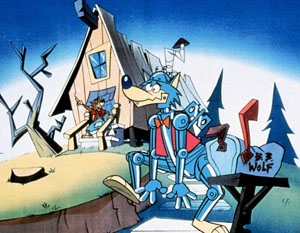 Next we see a grappling hook tossed onto the chimney. Its rope is connected to the robot, who pumps his tail like the lever of an auto jack to lift himself to the roof. He follows Big Bad’s old lead in a chimney descent, but is greeted by a fireplace fill of high explosives. He rockets out the chimney into space, taking a ricochet off the bottom of the space shuttle, then another off the bottom of the Jetsons’ space car! He makes a fiery re-entry into the atmosphere, reaching for a panel in his chest with a ring to pull a ripcord. He experiences the old Yogi Bear problem of a delayed reaction, as he crashes into the ground, deep into a crater, only then to have a parachute needlessly pop out. His next assault is from a tree limb, bouncing down upon springs emerging from his heels, for a leap into the upper story window. A calm-as-you-please pig awaits, producing a tennis racket, and delivering a smash which shoots the robot out the window again. He ends up tangled in a clothesline, embarrassingly acquiring a woman’s dress for attire, and receiving a horse-laugh from an old nag upon whose back he happens to land. Another assault follows, with a huge skyrocket popping out of the robot’s back for propulsion. On cue, the cottage doors open again, letting the robot pass right through. He hits the ramp of a kiddie slide in the back yard, and is propelled into the sky, where the rocket explodes in a Fourth-of-July display, briefly blasting the robot into component parts, which reassemble themselves upon hitting ground – only with the one flaw of interchanged positions between the robot’s tai; and head. Next, the robot unscrews one hand, installing in its place a boxing glove. He knocks at the front door, poised to give whoever answers it a sock. However, he fails to notice a smaller panel in the upper section of the door open, from which an even larger boxing glove emerges on a jack-in-the-box spring. The robot’s head is knocked off, falling on the ground. “Hey, rest of me. I’m over here”, the head calls to its body. The eyeless body fails to notice him, stepping forcibly upon the head’s face – then picking up a large boulder which it believes is its lost head. “Hey, ta bucket of bolts. What’re ya’ doin’ with that?” asks the head. The body unit, realizing its mistake, drops the boulder – right on the head, flattening it before reassembly, upside down on the robot’s neck. Finally, an old gag is always worth warming over, as the robot loads a cannon at the pigs’ door, and lights the fuse. The door opens as a pig flips the cannon barrel over, re-aiming it at the wolf. BOOM! The wolf robot is a pile of disconnected parts. The debris is scooped up by a bulldozer driven by the pigs, and transported back to the shack of the Big Bad Wolf, where it is dumped on the porch with a shout of “Special delivery.” Big Bad is aghast at the wreckage. “What did they do to ya? Speak to me, old buddy.” The battered robot head weakly suggests, “Say, boss, what’d’ya say we just order out for pizza?” Quite a lot of material to cram into seven minutes – but a little expertise in theatrical timing is all it takes.
Next we see a grappling hook tossed onto the chimney. Its rope is connected to the robot, who pumps his tail like the lever of an auto jack to lift himself to the roof. He follows Big Bad’s old lead in a chimney descent, but is greeted by a fireplace fill of high explosives. He rockets out the chimney into space, taking a ricochet off the bottom of the space shuttle, then another off the bottom of the Jetsons’ space car! He makes a fiery re-entry into the atmosphere, reaching for a panel in his chest with a ring to pull a ripcord. He experiences the old Yogi Bear problem of a delayed reaction, as he crashes into the ground, deep into a crater, only then to have a parachute needlessly pop out. His next assault is from a tree limb, bouncing down upon springs emerging from his heels, for a leap into the upper story window. A calm-as-you-please pig awaits, producing a tennis racket, and delivering a smash which shoots the robot out the window again. He ends up tangled in a clothesline, embarrassingly acquiring a woman’s dress for attire, and receiving a horse-laugh from an old nag upon whose back he happens to land. Another assault follows, with a huge skyrocket popping out of the robot’s back for propulsion. On cue, the cottage doors open again, letting the robot pass right through. He hits the ramp of a kiddie slide in the back yard, and is propelled into the sky, where the rocket explodes in a Fourth-of-July display, briefly blasting the robot into component parts, which reassemble themselves upon hitting ground – only with the one flaw of interchanged positions between the robot’s tai; and head. Next, the robot unscrews one hand, installing in its place a boxing glove. He knocks at the front door, poised to give whoever answers it a sock. However, he fails to notice a smaller panel in the upper section of the door open, from which an even larger boxing glove emerges on a jack-in-the-box spring. The robot’s head is knocked off, falling on the ground. “Hey, rest of me. I’m over here”, the head calls to its body. The eyeless body fails to notice him, stepping forcibly upon the head’s face – then picking up a large boulder which it believes is its lost head. “Hey, ta bucket of bolts. What’re ya’ doin’ with that?” asks the head. The body unit, realizing its mistake, drops the boulder – right on the head, flattening it before reassembly, upside down on the robot’s neck. Finally, an old gag is always worth warming over, as the robot loads a cannon at the pigs’ door, and lights the fuse. The door opens as a pig flips the cannon barrel over, re-aiming it at the wolf. BOOM! The wolf robot is a pile of disconnected parts. The debris is scooped up by a bulldozer driven by the pigs, and transported back to the shack of the Big Bad Wolf, where it is dumped on the porch with a shout of “Special delivery.” Big Bad is aghast at the wreckage. “What did they do to ya? Speak to me, old buddy.” The battered robot head weakly suggests, “Say, boss, what’d’ya say we just order out for pizza?” Quite a lot of material to cram into seven minutes – but a little expertise in theatrical timing is all it takes.
 Developing first out of a student film, then a pilot and follow-up episodes for “What a Cartoon Show”, the Powerpuff Girls were born. From their subsequent highly-successful series came Uh Oh. Dynamo (The Powerpuff Girls, 5/26/99) – an episode with great promise, but which gives the feeling of being inordinately stretched from an intended 10-minute running time to a full 21 minutes, allowing for some dramatic visuals but plot development which is sometimes as pokey as the Pokey Oaks School. On an outing at a park lake in Townsville’s equivalent of Little Tokyo, a peaceful Saturday is disturbed by odd eyeballs rising from the lake. They all belong to a single, multi-eyed fish, who roars like a typical Japanese movie monster. “You’ve gotta be kidding”, remarks Buttercup, as the beast is only about two feet tall. However, it has the power of a blowfish, and inflates itself to a height of ten feet, then smacks at the girls and Professor Utonium with its fin. The beast is reasonably tough, knocking all four of them for a temporary loop. The Professor seems to have never been quite so close to danger before, and reacts as an over-protective father, “My babies.” The girls, however, remain unimpressed in spite of the smack, and show what they are made of (sugar, spice, and…well, I digress), by giving the beast a few socks on the jaw, then a belly-buster blow in the gut, which knocks the wind out of him, returning him to his original puny dimensions. The fish smiles meekly in embarrassment, as the girls kick him back into the lake. The panicked Professor clutches his girls, stating he thought he was going to lose them. Buttercup reminds him that they are superheroes, and fighting monsters is what they do. The Professor says nothing more, but the look on his face reads that something must be done to take the risk out of this situation.
Developing first out of a student film, then a pilot and follow-up episodes for “What a Cartoon Show”, the Powerpuff Girls were born. From their subsequent highly-successful series came Uh Oh. Dynamo (The Powerpuff Girls, 5/26/99) – an episode with great promise, but which gives the feeling of being inordinately stretched from an intended 10-minute running time to a full 21 minutes, allowing for some dramatic visuals but plot development which is sometimes as pokey as the Pokey Oaks School. On an outing at a park lake in Townsville’s equivalent of Little Tokyo, a peaceful Saturday is disturbed by odd eyeballs rising from the lake. They all belong to a single, multi-eyed fish, who roars like a typical Japanese movie monster. “You’ve gotta be kidding”, remarks Buttercup, as the beast is only about two feet tall. However, it has the power of a blowfish, and inflates itself to a height of ten feet, then smacks at the girls and Professor Utonium with its fin. The beast is reasonably tough, knocking all four of them for a temporary loop. The Professor seems to have never been quite so close to danger before, and reacts as an over-protective father, “My babies.” The girls, however, remain unimpressed in spite of the smack, and show what they are made of (sugar, spice, and…well, I digress), by giving the beast a few socks on the jaw, then a belly-buster blow in the gut, which knocks the wind out of him, returning him to his original puny dimensions. The fish smiles meekly in embarrassment, as the girls kick him back into the lake. The panicked Professor clutches his girls, stating he thought he was going to lose them. Buttercup reminds him that they are superheroes, and fighting monsters is what they do. The Professor says nothing more, but the look on his face reads that something must be done to take the risk out of this situation.
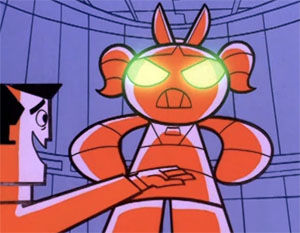 All night long, the Professor labors feverishly in the basement of his lab. When the girls rise in the morning, he has a surprise to show them – a ten-story tall giant robot, built in their image. She is called Dynamo – short for Dynamic Nanotechtronic Monobot. Her head unit has seating capacity for all three girls. Its titanium deflector shields allow it to curl up into an impenetrable shell, while its limbs, and even the locks of iits metallic hairdo, bristle with missiles. The Professor emotionally expresses to the girls that he is responsible for their safety and begs them for a promise to use the robot. Bubbles is in tears, while Buttercup remains unmoved. Blossom speaks for all of them, agreeing to the promise, but only if they really need it. A week goes by, and it is obvious the girls feel no real need for the robot, leaving it behind every day while carrying out their missions. The Professor begins to feel that his efforts have been in vain. Saturday arrives again, and the Little Tokyo lake is packed with junior bathers. An eye surfaces on the water again – but this time bigger. The little fish who started the trouble is there – but this time, he’s brought along his Mommy – about fifty times his size. Along with her brute strength, this fish also exhales heat rays that can set structures on fire. The Powerpuffs arrive, but are swatted between the fish’s fins like three wounded flies. The Professor finally issues them an order – use the Dynamo or be grounded. An epic battle begins – almost. The girls prepare to attack, but the robot covers itself with the titanium shields and rolls up into a ball. The fish responds by batting the ball with its tail, smacking the robot through half a dozen buildings, and on top of City Hall. Blossom discovers that the Professor left the safety switch on on the robot’s dashboard. “I was worried”, apologizes the Professor from a TV monitor. With the switch turned off, the robot activates all of its missile firepower, and lets it fly. Missiles explode everywhere, as the perplexed fish watches – finding itself unscathed in the center of town, but a perimeter of five city blocks leveled around it. The fish locates a long passenger train on an elevated railway, and lifts it off the tracks, snapping the train line a whop to attack the Dynamo. The Dynamo counters with a brilliant piece of strategy, uprooting a decorative sign in front of a bowling alley, on which appear the forms of three glowing illuminated stars. Separating the stars from the sign, the robot tosses them at the fish, ninja style. Each lodges in the lip of the fish, puncturing its inflated air reservoir. The fish quickly deflates like a toy balloon, soaring dizzily around in the skies, and drifting all the way to Mt. Rushmore, where is lies drooping over the Presidents’ heads. The robot dances a victory dance – while the ruins of the city lie around it in flames. The mayor arrives, and congratulates the girls on ridding them of the fish-balloon – but screams at them for destroying his beautiful town. The mayor orders the girls never to use the robot again. The girls point out that it was the Professor that made them do it. “Professor!”, responds the citizenry in unison. “Gotta go”, says the Professor sensibly in his helicopter, and makes a timely departure, as the narrator observes that just because you’re a genius doesn’t make you a smart guy.
All night long, the Professor labors feverishly in the basement of his lab. When the girls rise in the morning, he has a surprise to show them – a ten-story tall giant robot, built in their image. She is called Dynamo – short for Dynamic Nanotechtronic Monobot. Her head unit has seating capacity for all three girls. Its titanium deflector shields allow it to curl up into an impenetrable shell, while its limbs, and even the locks of iits metallic hairdo, bristle with missiles. The Professor emotionally expresses to the girls that he is responsible for their safety and begs them for a promise to use the robot. Bubbles is in tears, while Buttercup remains unmoved. Blossom speaks for all of them, agreeing to the promise, but only if they really need it. A week goes by, and it is obvious the girls feel no real need for the robot, leaving it behind every day while carrying out their missions. The Professor begins to feel that his efforts have been in vain. Saturday arrives again, and the Little Tokyo lake is packed with junior bathers. An eye surfaces on the water again – but this time bigger. The little fish who started the trouble is there – but this time, he’s brought along his Mommy – about fifty times his size. Along with her brute strength, this fish also exhales heat rays that can set structures on fire. The Powerpuffs arrive, but are swatted between the fish’s fins like three wounded flies. The Professor finally issues them an order – use the Dynamo or be grounded. An epic battle begins – almost. The girls prepare to attack, but the robot covers itself with the titanium shields and rolls up into a ball. The fish responds by batting the ball with its tail, smacking the robot through half a dozen buildings, and on top of City Hall. Blossom discovers that the Professor left the safety switch on on the robot’s dashboard. “I was worried”, apologizes the Professor from a TV monitor. With the switch turned off, the robot activates all of its missile firepower, and lets it fly. Missiles explode everywhere, as the perplexed fish watches – finding itself unscathed in the center of town, but a perimeter of five city blocks leveled around it. The fish locates a long passenger train on an elevated railway, and lifts it off the tracks, snapping the train line a whop to attack the Dynamo. The Dynamo counters with a brilliant piece of strategy, uprooting a decorative sign in front of a bowling alley, on which appear the forms of three glowing illuminated stars. Separating the stars from the sign, the robot tosses them at the fish, ninja style. Each lodges in the lip of the fish, puncturing its inflated air reservoir. The fish quickly deflates like a toy balloon, soaring dizzily around in the skies, and drifting all the way to Mt. Rushmore, where is lies drooping over the Presidents’ heads. The robot dances a victory dance – while the ruins of the city lie around it in flames. The mayor arrives, and congratulates the girls on ridding them of the fish-balloon – but screams at them for destroying his beautiful town. The mayor orders the girls never to use the robot again. The girls point out that it was the Professor that made them do it. “Professor!”, responds the citizenry in unison. “Gotta go”, says the Professor sensibly in his helicopter, and makes a timely departure, as the narrator observes that just because you’re a genius doesn’t make you a smart guy.
 We still have space for one installment of another illustrious graduate of the “What a Cartoon Show” – Dexter’s Laboratory, a semi-classic, innovative tale of diabolical junior genius and sibling rivalry, unique in its simplistic graphic style mixed with complicated gadgets and gizmos and camera techniques frequently borrowing and modifying from anime. The series became a Cartoon Network perennial and one of its early hits, spanning several seasons. It’s difficult to say how many times Dexter turned to the field of robotics in his experiments in his secret underground lab – which sometimes weren’t so secret, as he would often trot his inventions out into public view. Plot consistency wasn’t a priority from episode to episode, and so the fact that his lab was supposed to be unknown to his parents was just something we were supposed to accept – even though only the dimmest of bulbs could possibly have not noticed it. The premise and mood were always kept light and slightly silly, so that the audience soon learned not to be too picky about it – just go with it for the fun and the personalities. For this week, we’ll include a well-remembered exemplar from the first season, that seems to have hit home with many viewers.
We still have space for one installment of another illustrious graduate of the “What a Cartoon Show” – Dexter’s Laboratory, a semi-classic, innovative tale of diabolical junior genius and sibling rivalry, unique in its simplistic graphic style mixed with complicated gadgets and gizmos and camera techniques frequently borrowing and modifying from anime. The series became a Cartoon Network perennial and one of its early hits, spanning several seasons. It’s difficult to say how many times Dexter turned to the field of robotics in his experiments in his secret underground lab – which sometimes weren’t so secret, as he would often trot his inventions out into public view. Plot consistency wasn’t a priority from episode to episode, and so the fact that his lab was supposed to be unknown to his parents was just something we were supposed to accept – even though only the dimmest of bulbs could possibly have not noticed it. The premise and mood were always kept light and slightly silly, so that the audience soon learned not to be too picky about it – just go with it for the fun and the personalities. For this week, we’ll include a well-remembered exemplar from the first season, that seems to have hit home with many viewers.
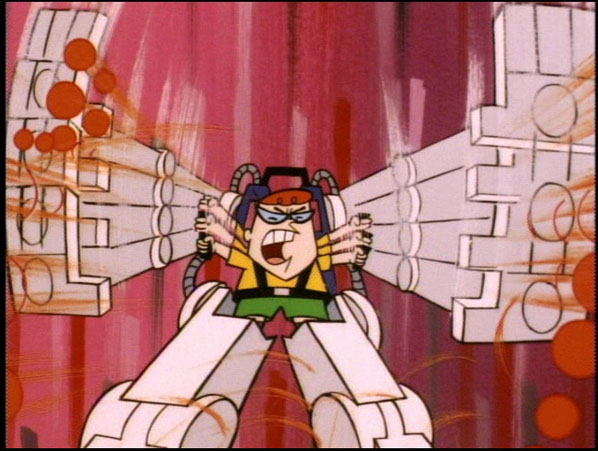 Dexter Dodgeball (5/5/96) – Morning dawns at Dexter’s residence. The boy genius has his morning routine completely automated, using some ideas that seem right out of the Jetsons, with a vacuum tube to suck him out of bed, and a conveyor belt full of gadgets to get him showered and dressed in the fashion of an automatic car wash. His family nemesis, big sister Dee Dee, takes a back seat in this episode, although she is briefly seen engaged in her dimwitted meddling down in the lab, anointing one of Dexter’s inventions with decorative lipstick and a ballet tutu. Before Dexter leaves for school, he approaches a pedestal where a special object is placed in prominence under a glass dome – a piece of paper, on which are emblazoned the magic words “Gym Excuse”. Dexter is obviously not the athletic type, having no muscles and appearing about two feet in stature, and a chorus of heavenly voices is heard as he takes this precious artifact out of its casing – his life-saving ticket for survival through the average school day. However, this is not to be his day. As usual when gym period is called at school, Dexter presents his note to the window of the gym instructor, reading “Please exuse Dexter forever.” But an unfamiliar voice behind the window responds “What’s this cra_?” A huge shadow looms over Dexter, followed by an equally huge hulk of an instructor, who identifies himself as the new substitute coach. Dexter stammers, then manages to utter “B-but my excuse.” “What excuse??!!” snarls the coach, tearing the precious document in two. “SUIT UP!!!” he roars, blowing his whistle, then announces the day’s activity – “DODGE BALL!!!!” For the first time, Dexter is subjected to a sport he has no idea how to handle. His comrades on the field quickly fall around him, as a trio of bullies who are the reigning school champs of the game systematically take them out of battle with stunning blows from their flying orbs. Now only Dexter remains standing against them – the trio having saved dessert for last. Over the course of a week’s activities, Dexter receives every kind of blow imaginable as the trio hurl their spheres at him. One of the best gags has a ball, on which the brand name “Boit” (instead of “Voit”) visibly appears, hitting Dexter so hard in the forehead that he is left with a reverse-impression of the trademark etched across his head. The weekend finally arrives, Dexter having barely survived a Friday afternoon low blow that hit where a boy would feel it the most, and Dexter lies sleepless at night, still doubled up in pain, and visualizing nightmares of the next week ahead. A day’s reflection gets his mind percolating, Dexter style, and his weekend is spent busy with secret activity in the lab. When P.E. period arrives the following Monday, the bullies now find themselves in a looming shadow. Dexter has suited up in his own fashion – a huge, robotic suit of armor, equipped with both shields and jet-propelled ball-launchers. Now, it’s the bullies’ turn to dodge rubber, as Dexter delights in doling out all he has taken over the past week, plus a goodly dose more for vengeance. With all the camera moves of an anime battle, Dexter scores hit after hit upon the trio – even resorting to flushing out one of the three who takes refuge under the jungle gym by launching in two sticks of lit dynamite, just to get through his score with the rubber sphere. Dexter stands in a glowing aura, triumphant over the playground as the last man standing. Note I did say, “man”, as in his moment of victory, one last ball appears from nowhere, conking Dexter on the head. “You’re out”, rings out the all-too-familiar voice of his meddling sister Dee Dee, appearing from nowhere for the final shot, as Dexter collapses for the iris out.
Dexter Dodgeball (5/5/96) – Morning dawns at Dexter’s residence. The boy genius has his morning routine completely automated, using some ideas that seem right out of the Jetsons, with a vacuum tube to suck him out of bed, and a conveyor belt full of gadgets to get him showered and dressed in the fashion of an automatic car wash. His family nemesis, big sister Dee Dee, takes a back seat in this episode, although she is briefly seen engaged in her dimwitted meddling down in the lab, anointing one of Dexter’s inventions with decorative lipstick and a ballet tutu. Before Dexter leaves for school, he approaches a pedestal where a special object is placed in prominence under a glass dome – a piece of paper, on which are emblazoned the magic words “Gym Excuse”. Dexter is obviously not the athletic type, having no muscles and appearing about two feet in stature, and a chorus of heavenly voices is heard as he takes this precious artifact out of its casing – his life-saving ticket for survival through the average school day. However, this is not to be his day. As usual when gym period is called at school, Dexter presents his note to the window of the gym instructor, reading “Please exuse Dexter forever.” But an unfamiliar voice behind the window responds “What’s this cra_?” A huge shadow looms over Dexter, followed by an equally huge hulk of an instructor, who identifies himself as the new substitute coach. Dexter stammers, then manages to utter “B-but my excuse.” “What excuse??!!” snarls the coach, tearing the precious document in two. “SUIT UP!!!” he roars, blowing his whistle, then announces the day’s activity – “DODGE BALL!!!!” For the first time, Dexter is subjected to a sport he has no idea how to handle. His comrades on the field quickly fall around him, as a trio of bullies who are the reigning school champs of the game systematically take them out of battle with stunning blows from their flying orbs. Now only Dexter remains standing against them – the trio having saved dessert for last. Over the course of a week’s activities, Dexter receives every kind of blow imaginable as the trio hurl their spheres at him. One of the best gags has a ball, on which the brand name “Boit” (instead of “Voit”) visibly appears, hitting Dexter so hard in the forehead that he is left with a reverse-impression of the trademark etched across his head. The weekend finally arrives, Dexter having barely survived a Friday afternoon low blow that hit where a boy would feel it the most, and Dexter lies sleepless at night, still doubled up in pain, and visualizing nightmares of the next week ahead. A day’s reflection gets his mind percolating, Dexter style, and his weekend is spent busy with secret activity in the lab. When P.E. period arrives the following Monday, the bullies now find themselves in a looming shadow. Dexter has suited up in his own fashion – a huge, robotic suit of armor, equipped with both shields and jet-propelled ball-launchers. Now, it’s the bullies’ turn to dodge rubber, as Dexter delights in doling out all he has taken over the past week, plus a goodly dose more for vengeance. With all the camera moves of an anime battle, Dexter scores hit after hit upon the trio – even resorting to flushing out one of the three who takes refuge under the jungle gym by launching in two sticks of lit dynamite, just to get through his score with the rubber sphere. Dexter stands in a glowing aura, triumphant over the playground as the last man standing. Note I did say, “man”, as in his moment of victory, one last ball appears from nowhere, conking Dexter on the head. “You’re out”, rings out the all-too-familiar voice of his meddling sister Dee Dee, appearing from nowhere for the final shot, as Dexter collapses for the iris out.
We’ll likely return to Dexter’s further adventures in a subsequent installment. A mish-mosh of more studios, next time.
